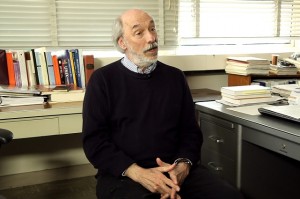The Stability of the Solar System
Institute for Advanced Study Prof. Scott Tremaine on the universal law of gravity, predictability and chaos in...
I would like to talk about one of the most beautiful successes of mathematics and physics – the classification of elementary particles by making use of spacetime symmetries. Before that I should explain what spacetime symmetries are. There are the symmetries of space – they essentially tell you that space is homogeneous – i.e. all points are equal in space. At least, in empty space or if here is only one particle to probe it, which is what we will discuss later. Another property of space is isotropy: all directions in space are equal.
Imagine that you are in a train departing from a station at constant velocity, in straight motion and with no acceleration. If you see another train, you cannot instantly tell which one is moving. Are you departing from the station or is it the other train on the other side? If you don’t have much else to see, it can be confusing. Also, if you close the curtain while you are inside the train, you may not be sure whether you are at rest or in motion. This is precisely the principle of Einstein’s relativity. But not Einstein’s only – in some sense it goes back to Galilei. He gave a different example: if you are on a boat and throw a ball in a boat that goes at constant speed, it will fortunately fall in the same way that if you were on the ground, at rest. That’s a very important principle.
Symmetries are always about what is invariant in practice. In this case it’s the laws of physics themselves, the properties of space and time that are invariant under some transformation. Some transformations are translations in space and time. Wherever you are in space and time they remain the same. But relativity means that if you move in space and time in some way, if you go along some directions in space and time, the laws of physics are the same. So, in practice, all observers which are in uniform motion along straight lines with respect to one another observe the same laws of physics – more precisely, they are called ‘inertial observers’.
What is relative and what is not, what transforms and what does not is a very important question in symmetries. What is relative with respect to the relativity principle? It is the fact that velocity is a relative concept – you are moving with respect to me and it’s me moving with respect to you. The distance is always between two points, so the velocities are always between one observer with respect to another or vice versa.
As Einstein told us, it is not totally true. In the usual relativity principle, which goes back to Galilei, it is true that all velocities are equal and all of them are relative as they don’t have intrinsic meaning. But since in symmetries the important thing is what is invariant, you may ask what is invariant in Galilean relativity? In that case, it is the separation between space and time. And, indeed, we are used to the fact that we know what space is at a given moment and we know what time is by looking at a clock – but we don’t have the a priori concept of something unified. It’s spacetime, but it’s still separated between space and time. The separation is absolute in the Galilean relativity.
Surprisingly enough, the laws of electromagnetism give you one speed that is not equal to the others – the speed of light. It tells that it’s not like in Galilean relativity, where all speeds and velocities are equal – there’s one absolute velocity which will be the same to all observers. This breaks the separation of space and time completely. If there’s a single velocity that appears the same to all observers, the only way to reconcile this with the usual way to describe motion, to measure distance and time and to reconcile the principle of relativity and the absoluteness of the speed of light is the concept of space and time not being relative. In other words, the length and the time lapse between two evens will depend on the observer that measures them. That was the breakthrough of Einstein’s – to be as bold as to reconcile mechanics and electromagnetism by breaking down the separation between time and space and by saying that they both are relative notions.

Institute for Advanced Study Prof. Scott Tremaine on the universal law of gravity, predictability and chaos in...

Physicist Frank Taylor on quarks, muons, and the Standard Model

What do we know about them?